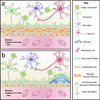The role of APOE in cerebrovascular dysfunction
- PMID: 26884068
- PMCID: PMC4837016
- DOI: 10.1007/s00401-016-1547-z
The role of APOE in cerebrovascular dysfunction
Abstract
The ε4 allele of the apolipoprotein E gene (APOE4) is associated with cognitive decline during aging, is the greatest genetic risk factor for Alzheimer's disease and has links to other neurodegenerative conditions that affect cognition. Increasing evidence indicates that APOE genotypes differentially modulate the function of the cerebrovasculature (CV), with apoE and its receptors expressed by different cell types at the CV interface (astrocytes, pericytes, smooth muscle cells, brain endothelial cells). However, research on the role of apoE in CV dysfunction has not advanced as quickly as other apoE-modulated pathways. This review will assess what aspects of the CV are modulated by APOE genotypes during aging and under disease states, discuss potential mechanisms, and summarize the therapeutic significance of the topic. We propose that APOE4 induces CV dysfunction through direct signaling at the CV, and indirectly via modulation of peripheral and central pathways. Further, that APOE4 predisposes the CV to damage by, and exacerbates the effects of, additional risk factors (such as sex, hypertension, and diabetes). ApoE4-induced detrimental CV changes include reduced cerebral blood flow (CBF), modified neuron-CBF coupling, increased blood-brain barrier leakiness, cerebral amyloid angiopathy, hemorrhages and disrupted transport of nutrients and toxins. The apoE4-induced detrimental changes may be linked to pericyte migration/activation, astrocyte activation, smooth muscle cell damage, basement membrane degradation and alterations in brain endothelial cells.
Keywords: Aging; Alzheimer’s disease; Apolipoprotein E; Blood–brain barrier; Cerebrovascular dysfunction.
Figures




References
-
- Allen N, Robinson AC, Snowden J, Davidson YS, Mann DM. Patterns of cerebral amyloid angiopathy define histopathological phenotypes in Alzheimer's disease. Neuropathol Appl Neurobiol. 2014;40:136–148. - PubMed
-
- Alonzo NC, Hyman BT, Rebeck GW, Greenberg SM. Progression of cerebral amyloid angiopathy: accumulation of amyloid-beta40 in affected vessels. J Neuropathol Exp Neurol. 1998;57:353–359. - PubMed
Publication types
MeSH terms
Substances
Grants and funding
- RF1AG051504/AG/NIA NIH HHS/United States
- P50AG016574/AG/NIA NIH HHS/United States
- R01AG046205/AG/NIA NIH HHS/United States
- P01 NS074969/NS/NINDS NIH HHS/United States
- R01 AG027924/AG/NIA NIH HHS/United States
- R01AG027924/AG/NIA NIH HHS/United States
- R01 AG046205/AG/NIA NIH HHS/United States
- R01AG035355/AG/NIA NIH HHS/United States
- P50 AG016574/AG/NIA NIH HHS/United States
- P01AG030128/AG/NIA NIH HHS/United States
- RF1 AG051504/AG/NIA NIH HHS/United States
- P01 AG030128/AG/NIA NIH HHS/United States
- R01 AG035355/AG/NIA NIH HHS/United States
- P01NS074969/NS/NINDS NIH HHS/United States
- RF1 AG046205/AG/NIA NIH HHS/United States
LinkOut - more resources
Full Text Sources
Other Literature Sources
Miscellaneous

